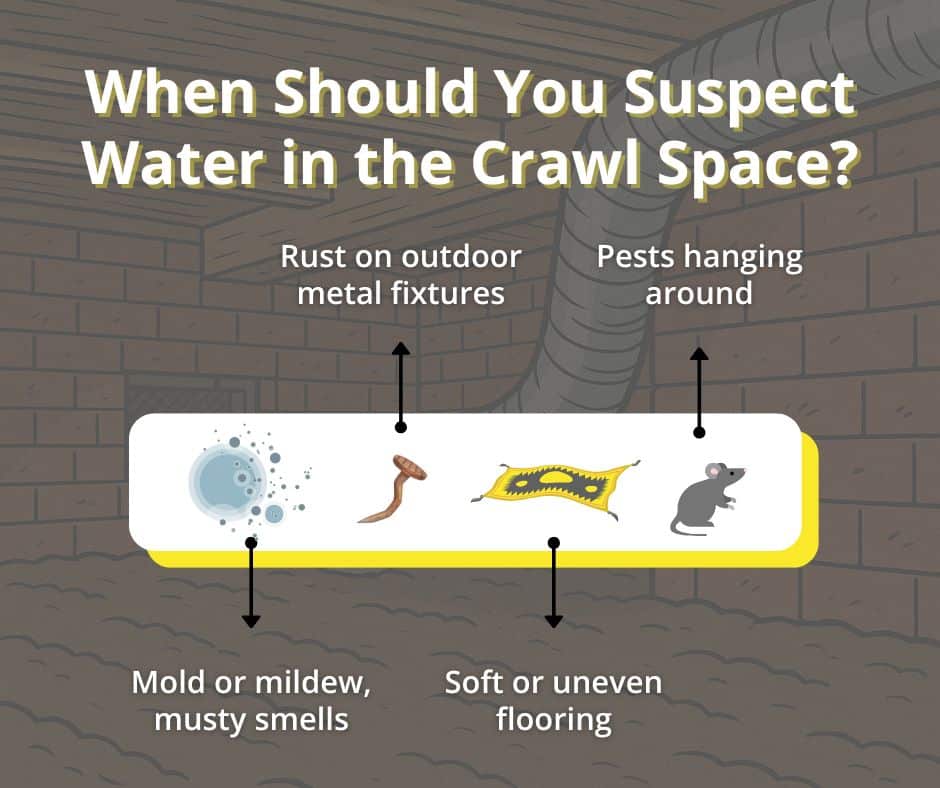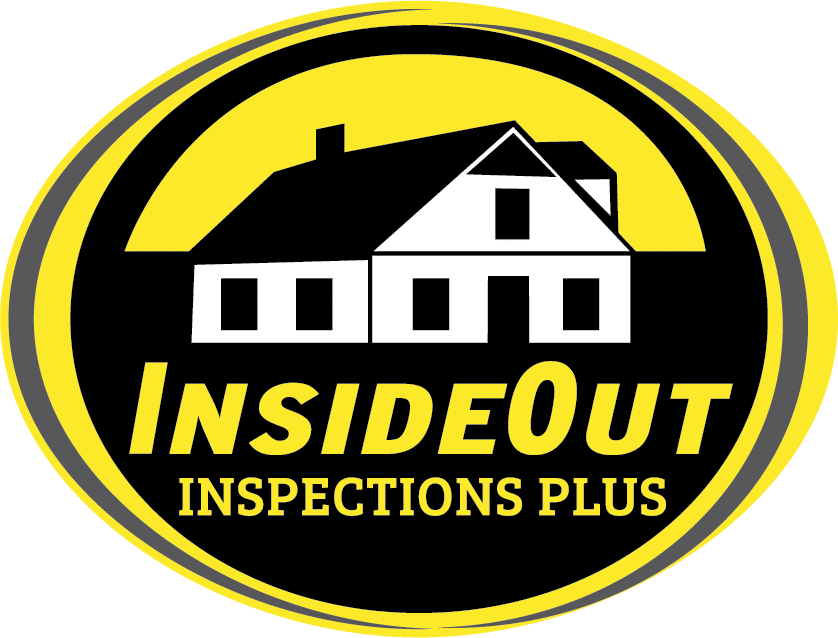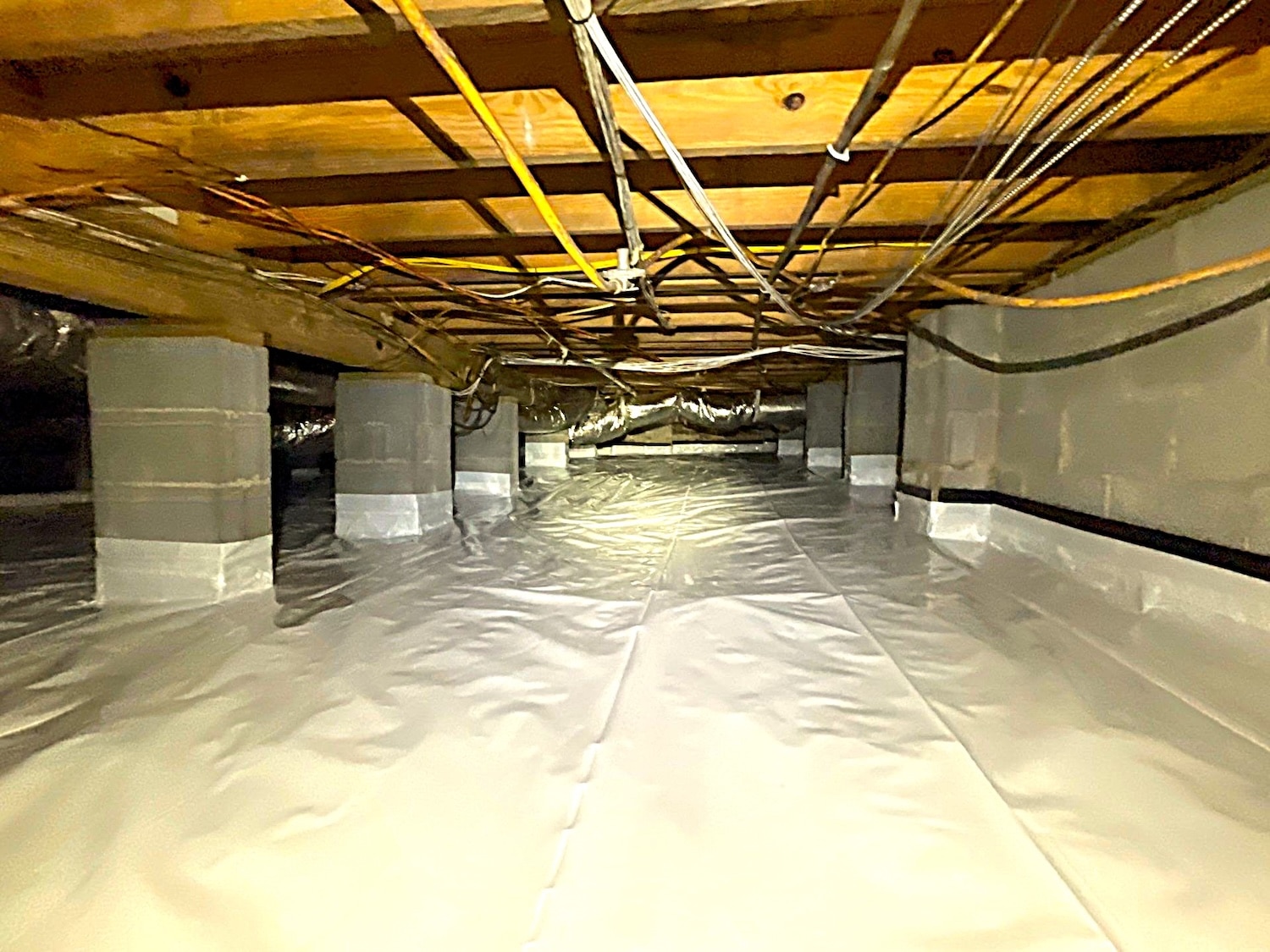Finding water in your crawl space is never a welcome surprise. Whether it’s just a little dampness or full-blown puddles, moisture under your home can lead to much bigger problems if left unchecked. Mold, pests, wood rot, and even rising energy bills can all start right beneath your feet.
But before you panic, let’s take a closer look at why there might be water in your crawl space and what you can do about it.
Confirming Crawl Space Water Issues
Water in a crawl space isn’t always obvious. Sometimes it’s easy to miss, especially if you don’t peek under your home very often. But there are clear warning signs that something isn’t right.
If you’ve noticed a musty smell in your house, especially near the floors, that could be a clue. You might also see soft or sagging spots in your flooring, which can point to moisture weakening the supports underneath.
Condensation on ductwork or insulation is another red flag, even if you don’t see standing water. And if you ever spot mold, mildew, or pests like insects or rodents making themselves at home down there, chances are good that moisture is part of the problem.

In fact, the EPA estimates that about 60% of homes in the United States have crawl space moisture issues. So if you’re dealing with this, you’re not alone.
What Causes Water to Collect in a Crawl Space?
The reasons for water in a crawl space can vary from home to home, but there are a few common culprits that tend to come up again and again.
One of the biggest causes is poor drainage around the outside of the house. If the ground slopes toward your foundation or your gutters aren’t doing their job, rainwater can collect near the base of your home and slowly seep into the crawl space. Even small amounts of water can add up over time.
Heavy rains and seasonal flooding can also push water into places it doesn’t belong. When the ground gets saturated, water has to go somewhere, and sometimes that somewhere is under your house.
Plumbing leaks are another sneaky source of crawl space moisture. A slow drip from a pipe might not seem like a big deal, but if it’s dripping into the crawl space for weeks or months, it can create major issues.
For some homes, the challenge comes from high groundwater levels. In areas where the water table is naturally high, moisture can rise up from the soil and collect under your home, especially if the crawl space isn’t properly sealed.
And finally, if your crawl space is missing a vapor barrier or the existing one is damaged, even normal ground moisture can start to build up. Without a barrier in place, there’s nothing to stop that dampness from creeping in.
Why It’s a Problem You Can’t Ignore
It’s easy to brush off a little moisture in the crawl space, especially if it’s out of sight. But ignoring it can lead to a whole list of bigger problems that affect not just the crawl space, but the entire home.
Mold and mildew thrive in damp, dark spaces. Once they start growing, they can spread quickly. Mold spores can enter your living space through the air, triggering allergies and other health issues.
It only takes about 24 to 48 hours for mold to start growing in wet conditions, which means it doesn’t take long for a small issue to get worse.
Moisture also weakens wood over time. The beams and joists that hold up your house can start to rot if they stay damp for too long. This can lead to sagging or uneven floors, and in extreme cases, serious structural damage.
Pests love a damp crawl space, too. Termites, carpenter ants, and rodents all look for places with moisture, which makes a wet crawl space the perfect home for them. Once they settle in, they can cause further damage by chewing through wood, insulation, and even electrical wiring.
Even your energy bills can take a hit. Moisture can ruin insulation, making it harder to keep your home warm in the winter and cool in the summer.
As a result, your heating and cooling systems have to work harder, which means higher utility costs.
How to Prevent Water in Your Crawl Space
The best way to deal with water in your crawl space is to stop it from getting there in the first place, and there are a few practical steps you can take to do that.
- Clean your gutters regularly and make sure downspouts direct water at least 6 feet away
- Regrade the soil around your home so that it slopes away
- Check for leaks in plumbing and have them fixed ASAP
- Seal crawl space vents to prevent humid air
- Install a vapor barrier in the crawl space to stop moisture from the ground from rising
For areas that tend to flood or stay damp, adding a sump pump or full crawl space encapsulation system may be worth considering.
The process can cost anywhere from $5,000 to $15,000, depending on the size of your home and the condition of the space, but it can be a worthwhile investment for long-term protection.

Other Maintenance Tips for a Healthy Crawl Space
Keeping water out is just one piece of the puzzle when it comes to maintaining a healthy crawl space.
Even if there are no visible issues, moisture can slowly build up over time without regular attention. Here’s what to keep in mind:
- Schedule professional inspections every 1–2 years: Even if everything seems fine, hidden moisture, pests, or structural issues can go unnoticed until they become serious.
- Install a vapor barrier if you don’t have one: A vapor barrier is a thick plastic sheet that covers the ground, blocking moisture from rising into the crawl space. If your crawl space has bare soil or an old, damaged barrier, it’s time for an upgrade.
- Check your ventilation setup: Traditional crawl space vents can let in humid air, especially in warmer months. Sealing these vents and switching to a controlled ventilation system, or pairing it with a dehumidifier, helps keep moisture levels balanced year-round.
- Use a dehumidifier in damp climates: If your home is in a humid area, a crawl space dehumidifier can make a big difference. It helps prevent excess moisture, which protects your insulation, wood supports, and indoor air quality.
When to Call a Professional
DIY fixes can help with minor moisture issues, but some situations call for expert help. You should reach out to a professional if:
- There’s standing water in the crawl space
- You notice sagging floors or other signs of structural damage
- Mold or mildew keeps coming back
- You’ve had recurring pest problems under your home
- You’re not sure where the moisture is coming from
At InsideOut, our team helps homeowners across Michigan and Ohio get answers and solutions.
A professional crawl space inspection can uncover the source of the problem and recommend the right next steps, whether that’s moisture testing, mold assessment, or waterproofing guidance.
Conclusion
Water in a crawl space isn’t something to ignore. Whether it’s caused by poor drainage, plumbing leaks, or high humidity, moisture under your home can create real problems over time. Knowing what to look for and acting early can help you avoid costly repairs.
If you’re dealing with crawl space moisture and aren’t sure what to do next, InsideOut Plus will help. Schedule an inspection today to get clear answers and protect your home.


